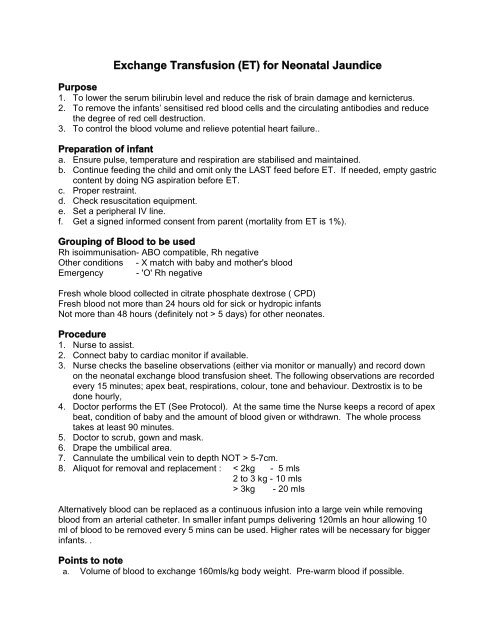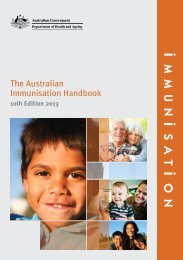Contents Chapter Topic Page Neonatology Respiratory Cardiology
Contents Chapter Topic Page Neonatology Respiratory Cardiology
Contents Chapter Topic Page Neonatology Respiratory Cardiology
You also want an ePaper? Increase the reach of your titles
YUMPU automatically turns print PDFs into web optimized ePapers that Google loves.
Exchange Transfusion (ET) for Neonatal Jaundice<br />
Purpose<br />
1. To lower the serum bilirubin level and reduce the risk of brain damage and kernicterus.<br />
2. To remove the infants’ sensitised red blood cells and the circulating antibodies and reduce<br />
the degree of red cell destruction.<br />
3. To control the blood volume and relieve potential heart failure..<br />
Preparation of infant<br />
a. Ensure pulse, temperature and respiration are stabilised and maintained.<br />
b. Continue feeding the child and omit only the LAST feed before ET. If needed, empty gastric<br />
content by doing NG aspiration before ET.<br />
c. Proper restraint.<br />
d. Check resuscitation equipment.<br />
e. Set a peripheral IV line.<br />
f. Get a signed informed consent from parent (mortality from ET is 1%).<br />
Grouping of Blood to be used<br />
Rh isoimmunisation- ABO compatible, Rh negative<br />
Other conditions - X match with baby and mother's blood<br />
Emergency - 'O' Rh negative<br />
Fresh whole blood collected in citrate phosphate dextrose ( CPD)<br />
Fresh blood not more than 24 hours old for sick or hydropic infants<br />
Not more than 48 hours (definitely not > 5 days) for other neonates.<br />
Procedure<br />
1. Nurse to assist.<br />
2. Connect baby to cardiac monitor if available.<br />
3. Nurse checks the baseline observations (either via monitor or manually) and record down<br />
on the neonatal exchange blood transfusion sheet. The following observations are recorded<br />
every 15 minutes; apex beat, respirations, colour, tone and behaviour. Dextrostix is to be<br />
done hourly,<br />
4. Doctor performs the ET (See Protocol). At the same time the Nurse keeps a record of apex<br />
beat, condition of baby and the amount of blood given or withdrawn. The whole process<br />
takes at least 90 minutes.<br />
5. Doctor to scrub, gown and mask.<br />
6. Drape the umbilical area.<br />
7. Cannulate the umbilical vein to depth NOT > 5-7cm.<br />
8. Aliquot for removal and replacement : < 2kg - 5 mls<br />
2 to 3 kg - 10 mls<br />
> 3kg - 20 mls<br />
Alternatively blood can be replaced as a continuous infusion into a large vein while removing<br />
blood from an arterial catheter. In smaller infant pumps delivering 120mls an hour allowing 10<br />
ml of blood to be removed every 5 mins can be used. Higher rates will be necessary for bigger<br />
infants. .<br />
Points to note<br />
a. Volume of blood to exchange 160mls/kg body weight. Pre-warm blood if possible.
















